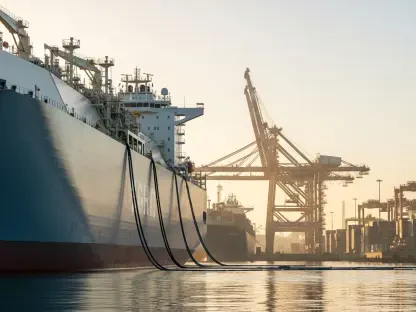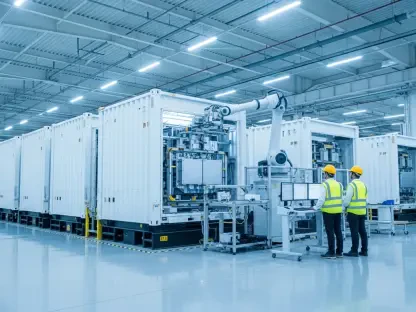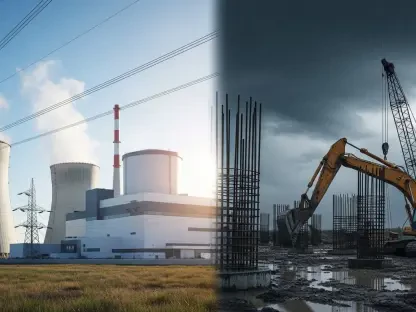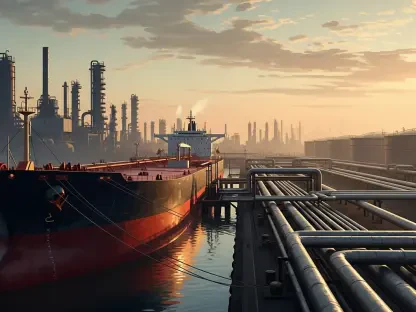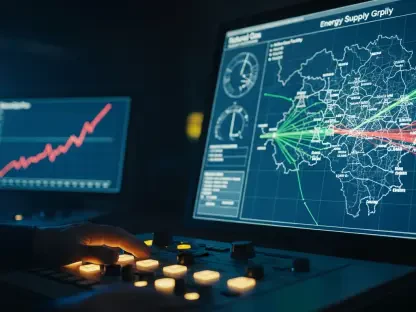The article discusses significant challenges and skepticism faced by North American railroads as they contemplate transitioning from traditional diesel fuels to alternative power sources in pursuit of zero-emissions technology. This topic was a central focus of a panel discussion titled “Toward Zero Emissions in Rail: Lessons Learned,” held at the Transportation Research Board’s 124th annual meeting. The debate brought to light various hurdles and opportunities in this ambitious endeavor, highlighting both immediate concerns and long-term goals.
The Current Dependence on Diesel
The Dominance of Diesel in Railroads
The American railroad industry has a profound reliance on diesel, as highlighted by Michael Nicoletti, a partner at Innovative Rail Technologies (IRT). Nicoletti humorously remarked, “We love diesel,” emphasizing that no alternative fuel currently matches the energy efficiency and cost-effectiveness of diesel. This dependency becomes even more evident considering that approximately 42,000 federally compliant locomotives operate on diesel, with many non-compliant units also in service. This extensive fleet, built over decades, represents a significant investment whose replacement or modification for alternative fuels poses both financial and operational challenges for the industry.
Diesel’s dominance in railroads is not just a matter of preference but a practical necessity given its reliability and well-established infrastructure. Locomotives powered by diesel can operate over long distances without the need for frequent refueling, which is particularly crucial for freight operations that span the vast expanses of the United States. Moreover, the existing supply chains and maintenance facilities are all geared towards supporting diesel technology, making the transition to zero-emission alternatives a complex proposition. The industry’s ingrained reliance on diesel also reflects a broader inertia in adopting new technologies, particularly those that require substantial upfront investments and come with uncertain returns.
Ecological and Health Impacts of Diesel Emissions
However, the transition away from diesel fuels is complicated not just by institutional inertia but also by the significant ecological and health impacts of diesel emissions. Emissions from diesel-operated locomotives, trucks, and ships contribute to approximately 30,000 premature deaths annually. Consequently, there is a global movement toward the reduction of diesel emissions and the evolution of an alternative fuel industry aimed at the rail sector. Reducing these harmful emissions has become a critical public health priority, particularly in urban areas where the concentration of pollutants can have immediate deleterious effects.
The adverse effects of diesel emissions extend beyond public health, also impacting the environment through the generation of greenhouse gases and particulate matter. These pollutants contribute to climate change, degradation of air quality, and acid rain, which affects ecosystems far removed from the point of emission. The transportation sector, including railroads, stands as a significant contributor to these environmental problems, amplifying the urgency to find viable zero-emission alternatives. As public and regulatory pressures mount for more sustainable practices, the rail industry faces the dual challenge of maintaining operational efficiency while drastically reducing its ecological footprint.
Regulatory Challenges and Technological Gaps
Inadequate Regulatory Frameworks
Marcin Taraskiewicz of HDR outlines another significant hurdle: the inadequate regulatory frameworks for zero-emissions (ZE) power sources in rail applications. While certain standards exist for ZE power sources in other industries, they are not yet adequately tailored for rail transport. Taraskiewicz emphasizes that future ZE regulatory standards must accommodate the unique contexts of rail transport, despite their current nonexistence. This regulatory gap leaves operators in a challenging position, where they must often define necessary requirements themselves, complicating risk analysis and regulatory approvals for ZE equipment.
The absence of specific regulations for ZE technology in railroads creates a vacuum that could hinder innovation and delay adoption. Without clear guidelines and standards, manufacturers and operators struggle with uncertainty regarding compliance and the long-term viability of their investments. The development of comprehensive and tailored regulatory frameworks is essential to facilitate a smoother transition, providing a clear roadmap for the industry to follow. Such regulations would not only ensure the safety and reliability of ZE technologies but also incentivize research and development by providing a predictable environment for investment.
Limited Availability of Rail-Specific ZE Components
The technological gaps are equally daunting, with few manufacturers currently producing rail-specific ZE components, such as batteries, fuel cells, and hydrogen tanks. Typically, these components are repurposed from marine, automotive, or industrial applications for use in rail environments. Consequently, they must undergo rigorous testing and validation to ensure they can withstand factors like shock, vibration, temperature extremes, duty cycles, and fire safety. Currently, the available ZE power options are mainly limited to multiple-unit passenger trains and short-range or yard locomotives. Leading the way in this niche sector are European manufacturers such as Siemens, Stadler, Alstom, CAF, and Talgo.
This limited availability of rail-specific ZE components poses significant challenges for broader adoption across the industry. The repurposing of components from other sectors often results in compromises on performance and reliability, which are critical factors in rail operations. Additionally, the extensive testing and validation processes increase the time and cost required to bring new technologies to market. As a result, the current offerings are confined to specific applications, such as short-range commuter trains, leaving long-range and heavy-haul operations reliant on diesel for the foreseeable future. This technological gap underscores the need for dedicated research and development efforts to create ZE solutions that meet the unique demands of the rail sector.
Energy-to-Weight Ratio and Long-Range Challenges
Energy-to-Weight Ratio Issues
Despite these advancements, long-range and heavy-haul fleets face significant energy-to-weight ratio issues with alternative fuels. Cleaner diesel fuels are being considered as they provide a high-energy output, but other alternatives like hydrogen and compressed natural gas are still under development. Taraskiewicz anticipates that fully developed standards for these technologies could take 10-15 years, during which time goalposts will continuously shift as technology advances. The energy-to-weight ratio is a critical parameter in rail transport, dictating the viability of different power sources for various applications. Diesel engines, with their high energy density, offer unparalleled efficiency for long-haul operations, a benchmark that alternative fuels have yet to match.
The challenge of developing alternative fuels with an adequate energy-to-weight ratio is compounded by the need to maintain operational efficiency and profitability. Long-haul freight trains, which can stretch for miles and carry thousands of tons of cargo, require immense power to move. Achieving the same performance levels with zero-emission technologies necessitates innovations that ensure energy efficiency without compromising on weight or space. This is particularly crucial because additional weight or bulk from alternative fuel systems can reduce cargo capacity, directly impacting the economic viability of freight transport.
Experimentation with Lithium-Ion Batteries
During this transition, Nicoletti mentions IRT’s experimentation with lithium-ion batteries in rail applications, implying the need for patient technological adoption before wider industry implementation. He underscores the importance of creating a support structure that includes better outreach from governmental agencies, highlighting the uncertainty railroad operators face due to a lack of clear directives. Lithium-ion batteries represent a promising zero-emission power source, offering high energy density and the potential for application in various rail contexts. However, the adoption of such technology requires extensive testing and adaptation to meet the specific demands of rail transport.
The experimentation with lithium-ion batteries in rail applications exemplifies the broader challenges faced by the industry in adopting new technologies. These batteries, while promising, need to prove reliable and safe under the rigorous operating conditions of rail transport. Moreover, the financial and logistical support from governmental agencies is crucial in facilitating their adoption. Clear directives and incentives are needed to encourage investment in research and development, ensuring that these technologies can be scaled up for wider industry implementation. The collaborative effort between public and private entities will be essential in overcoming the technological and regulatory hurdles that currently impede progress.
International Progress and North American Lag
Hydrogen-Powered Trains in Germany
Panelist Lynn Harris from DB E.C.O. North America offers a look at international progress with hydrogen-powered trains. While 27 trains in Germany are currently using hydrogen, North America is still catching up. According to Harris, hydrogen trains may reach cost parity with diesel in eight to fifteen years, and while hydrogen technology faces workforce and financial challenges, it also presents substantial public health benefits. These benefits are particularly significant in railyard-adjacent communities, where reducing diesel emissions can dramatically improve air quality and health outcomes. The experience of Germany demonstrates that with the right investment and regulatory support, hydrogen-powered trains can become a viable alternative to diesel.
The progress seen in Germany with hydrogen-powered trains highlights both the potential and the challenges of adopting ZE technologies in railroads. Hydrogen trains offer a promising zero-emission solution, capable of delivering the necessary power and range for various rail applications. However, the financial and workforce challenges associated with developing and deploying hydrogen technology are substantial. Achieving cost parity with diesel involves overcoming significant hurdles in the production, storage, and distribution of hydrogen fuel, as well as training a workforce capable of maintaining these new systems. The efforts in Germany serve as a model for North America, illustrating the path forward while also underscoring the need for substantial investment and coordinated efforts.
Federal Railway Administration’s Role
Absent any current regulations, the Federal Railway Administration (FRA) runs an Alternative Fuels Program that evaluates ZE energy sources. Despite the rail sector’s small share of total emissions, the FRA works to ensure the safety of ZE locomotives through comprehensive risk assessments. Notably, the FRA derives its regulatory authority from the Locomotive Inspection Act, mandating that locomotives in service be in a safe condition to operate. This regulatory oversight is crucial in maintaining the safety and reliability of locomotives, particularly as new technologies are introduced.
The role of the Federal Railway Administration (FRA) in evaluating and ensuring the safety of ZE locomotives is vital for the successful transition to alternative fuels. The FRA’s comprehensive risk assessments cover various aspects, from structural design and dynamic characteristics to emergency preparedness and risk mitigation. These evaluations help ensure that new power systems meet the stringent safety standards required for rail operations. The FRA’s involvement also underscores the importance of regulatory oversight in facilitating the adoption of ZE technologies, providing the necessary framework for safe and reliable implementation.
Safety and Regulatory Considerations
Comprehensive Risk Assessments
The evaluation of ZE energy sources for locomotives includes considerations linked to safety, structural design, dynamic characteristics, emergency preparedness, and risk mitigation. For instance, the modification of locomotives from diesel to battery power might reclassify them as “remanufactured” units, affecting their regulatory compliance status. These comprehensive risk assessments are essential in ensuring that new technologies do not compromise the safety and reliability of rail operations. The reclassification of modified locomotives underscores the complexity of regulatory compliance, highlighting the need for tailored standards that accommodate the specific requirements of ZE technologies.
Risk assessments play a critical role in the adoption of ZE energy sources, ensuring that new technologies meet the necessary safety and operational standards. These assessments cover a wide range of factors, from the structural integrity of locomotives to their dynamic performance under various conditions. Emergency preparedness is also a key consideration, with detailed planning required to handle potential incidents involving ZE technologies. By addressing these factors, the rail industry can mitigate the risks associated with adopting new power systems, ensuring a smooth and safe transition.
Hazard Risk Analysis and Documentation
The FRA also outlines that alternative energy sources, such as hydrogen gas or liquids, rechargeable battery systems, and other chemical-to-fuel technologies, require meticulous hazard risk analysis and transparent documentation for approval. These detailed regulatory considerations underscore the complexity of adopting new power systems within an industry primed for safety and reliability. The hazard risk analysis involves identifying potential hazards, assessing their likelihood and impact, and implementing measures to mitigate these risks. Transparent documentation is crucial in providing a clear record of these analyses and the steps taken to ensure safety.
Hazard risk analysis and documentation are essential components of the regulatory process, ensuring that alternative energy sources are safe for use in rail applications. The meticulous analysis involves a thorough examination of potential hazards associated with new technologies, including their storage, handling, and operation. This analysis is complemented by detailed documentation that provides a transparent record of the risk assessments and mitigation measures. This transparency is crucial for regulatory approval, providing the necessary assurance that new power systems meet the stringent safety standards required for rail operations.
Balancing Ecological Necessity and Practical Challenges
The article addresses the significant challenges and skepticism North American railroads face as they consider switching from traditional diesel fuels to alternative power sources to achieve zero-emissions technology. This subject was a primary topic during a panel discussion titled “Toward Zero Emissions in Rail: Lessons Learned,” which took place at the Transportation Research Board’s 124th annual meeting. The discussion highlighted a variety of obstacles and opportunities, emphasizing both immediate concerns and long-term goals.
Railroads in North America are grappling with how to transition from conventional diesel engines to cleaner, more sustainable energy sources. The panel brought to light key issues, such as the high cost of developing and implementing new technologies, infrastructure changes required, and regulatory hurdles. Furthermore, participants in the discussion explored the potential benefits such as reduced environmental impact and meeting future regulatory standards. The conversation underscored the ambitious nature of this shift and the need for strategic planning and investment to navigate the path toward zero-emissions rail transport.




